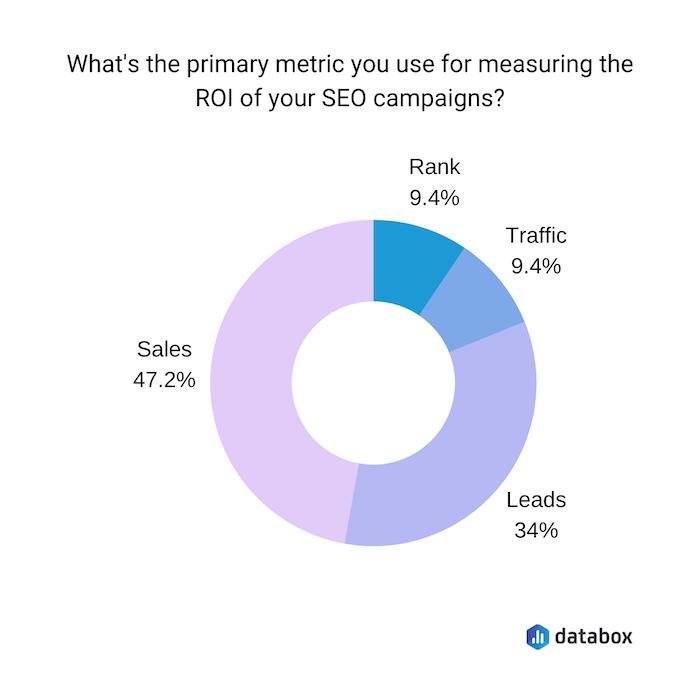
Top 15 Most Important SEO Metrics to Track Performance
Jan 8, 2021|Read time: 14 min.
Key Points
- SEO metrics allow you to measure the effectiveness of your SEO efforts and make corrective changes based on the data.
- If you don’t stay on top of key metrics, you’ll likely fail to notice both opportunities and threats.
- Many of the most important metrics map directly to Google ranking factors and are the ones you should monitor most closely.
One reason search engine optimization (SEO) is so effective is because you can track and measure everything. Whether you look at rankings, traffic, engagement, leads, orders, revenue, or authority, SEO metrics give you key insights into exactly how your organic search strategy performs.
Furthermore, SEO metrics are vital data points to build better strategies, or improve existing plans. But, how do you know which metrics to measure? After all, there are thousands of data points available across Google Analytics and SEO tools.
In this post, I’ll show you the 15 best SEO metrics to track plus the tools to monitor them.
Why SEO metrics matter
As the saying goes, if you don’t measure it, then you can’t manage it.
Without detailed tracking in place, you won’t discover opportunities to increase your organic search traffic and revenue. At the same time, your digital marketing radar could miss threats to your existing traffic and business. Moreover, there are plenty of relevant metrics for SEO that measure broader marketing performance.
SEO is always changing, and Google constantly updates their algorithm. With this in mind, it’s essential that you are regularly monitoring key SEO metrics to ensure that your site is healthy, properly optimized, and producing business benefits.
Value of Organic Search White Paper
See how an investment in organic search delivers ROI that compounds over time.
Top 15 SEO metrics to track
Not all KPIs and SEO success metrics are created equal. Though Google has approximately 200 ranking factors in their algorithm, some are more important than others.
To ensure you move the needle with your organic search performance, it’s important to focus on metrics that deliver the greatest impact. As a result, your SEO operation will deliver better ROI on marketing spend.
To that end, let’s look at the 15 most important SEO metrics you should be tracking on a regular basis.
1. New referring domains
Backlinks are one of the most important Google ranking factors. In most cases, relevant backlinks from high-quality domains will boost your domain authority. However, links from domains that have not linked to you previously tend to be more potent than additional links from websites that have already linked to you in the past.
In Google’s eyes, if a site already links to your domain, it means they view you as a trustworthy authority. A second link from the same website will be slightly less valuable than one from a new, comparable domain.
By all means, track your overall backlinks and referring domains. However, if you want your organic traffic to grow substantially, the number of new referring domains should also increase. Monitor this metric to ensure that your link building efforts support your SEO strategy.
2. Domain authority / domain rating
Domain Authority / Domain Rating is a score used by most major integrated SEO tools (Moz, Ahrefs, SEMrush, etc.) to calculate the overall SEO strength of a website. The score is calculated based on a number of factors, including number of backlinks, quality of referring domains, and more.
The score ranges from 0 to 100, and it’s built on a logarithmic scale. So, it’s much harder to increase the score from 80 to 81 than it is to increase from 20 to 21. Sites with higher scores are expected to rank better for search queries than those with lower scores, all things equal.
Now, to be clear, Domain Authority is not an official Google ranking factor. Nevertheless, it is important to monitor this metric because it is calculated based on things that are ranking factors. If you want to show up at the top of the search results, work towards increasing your Domain Authority.
Page Authority is also worth tracking for your most valuable landing pages. This metric measures the authority of specific pages rather than the entire domain.
3. On-page optimization scores
On-page optimization is the process of optimizing the contents of a page both for users and search engines. Tools Ahrefs Site Audit help you by analyzing a page and then providing a score that reflects how well the page is optimized for SEO. The score may take into account things like:
- Keyword density
- Keywords in headings and subheadings
- Instances of related keywords
- Related keywords in headings and subheadings
- Internal and external linking
- The meta description
- URL
- Canonical URL
- Page title
- Image alt tags
On-Page SEO Checklist
Get Terakeet’s checklist for on-page optimization and copywriting.
4. Text readability SEO metrics
Most SEO metrics track information like authority scores, backlinks, page views, traffic data, and target keyword rankings. Those metrics are important, but it’s also critical to track content quality. So how do you track the quality of site content?
Text readability and relevance are important for users because they deliver a frictionless experience. Moreover, they’re important to search engines like Google and Bing because they make your text easier to comprehend. Simply put, actionable content with clear takeaways is more valuable than overstuffed fluff.
Fortunately, there are ways to measure content quality.
Yoast provides you with a readability score for every page on your website, including a grade based on the Flesch reading ease score. Additionally, Yoast recommends using shorter sentences, paragraphs, and sections, as well as active voice and transition words. It’s not because those are ranking factors. It’s because they make your text easier to digest.
Tools like Clearscope, on the other hand, analyze content for relevance based on related search terms and entities found in competitor content. The more relevant terms you include from their list, the higher your grade.
Clearscope improves the comprehensiveness of your content marketing, and Yoast trims it down to be more digestible. Together, they can help you rank better in the search engine results pages (SERPs).
5. Impressions
Every time your page shows up in a Google search result, it counts as an impression, even if the user didn’t actually scroll down and see your listing. Impressions are an early indicator of your SEO campaign’s performance. As rankings improve, impressions will increase. Then, when you break into the top 3, your traffic will begin to surge.
You can easily track impressions through Google Search Console’s “Performance” module.
To be clear, impressions are not the same as clicks. Many would call them vanity metrics because they don’t drive traffic or revenue. Impressions are purely a record of how many times a particular page from your site appeared in the SERP.
6. Click-through rate (CTR)
CTR is the ratio of views to clicks. In the case of SEO, it tells you what percentage of impressions in the Google SERP actually generated a click-through to your web page. If 100 searchers see your listing in the search results and one person clicks it, then you have a CTR of 1%. Like impressions, you can also track CTR directly in Google Search Console’s “Performance” module.
There is a strong correlation between ranking position and CTR. The higher you rank on average, the more clicks you’ll earn. Although the first page of Google earns 90% of the clicks for a query, the majority of traffic comes from the top three positions in Google.
Here are some quick tips to improve your CTR on particular pages:
- Match your page title to search intent.
- Include a compelling CTA within your title if possible.
- Use brackets, dashes, or pipes to make your title stand out.
- Craft meta descriptions that entice users to click and read more.
- Evoke an emotional response through your title and meta description.
- Explain what they’ll walk away with after visiting your page.
- Use structured data to improve the way your page displays in search results.
- Use short, descriptive URLs that contain the primary keyword.
7. Keyword rankings
Keyword rankings are an obvious, yet critical SEO metric to track. They help you benchmark your progress, and they offer an early signal that your SEO strategy is working. Furthermore, rankings provide an overview of your current organic market share as well as the total opportunity.
When doing keyword research, focus on both branded and non-branded search terms. Branded keywords are important because they represent customers ready to buy. These terms are also vital to your online reputation. Conversely, non-branded terms for ecommerce products like “women’s running shoes” are essential for influencing customers in the decision making stage of the customer journey.
Although keyword rankings constantly fluctuate, a sudden drop in rankings could be signs of trouble. There are plenty of SERP trackers out there to choose from, including Ahrefs, Moz, SEMrush, and STAT.

8. Organic visibility (organic market share)
Organic visibility (aka organic market share, SEO visibility, search visibility, etc.) is a score that measures how much organic search traffic your site gets compared to the total available clicks. It takes into account both search volume and ranking position which drives click through rate (CTR).
Many SEO tools will give you a sitewide visibility score as well as a keyword-specific score. Both scores are important to track as they provide you with a quick snapshot of how your website’s SEO performance.
However, most existing tools only provide a snapshot without the ability to view trends. That’s why Terakeet developed Carina, proprietary software that provides a comprehensive look at your past, present, and projected online market presence.
It’s important to learn how to calculate market share based on organic traffic because those are essentially “free” visits from users searching for information in real time. Although organic market share seems like a simple metric, it actually reveals how well you target and connect with your ideal customers.
Terakeet uses organic market share reports like the one below to illustrate the power of high-level search performance as a metric.
9. Organic traffic
To state the obvious, you should be tracking the amount of organic search traffic your site gets. It is a key SEO metric that tells you whether your SEO efforts are delivering the foundations of a successful SEO program.
Without organic traffic, there can be no SEO-based conversions or revenue. If you’re not getting traffic, then something is clearly not working and needs to be remedied.
You can track your organic traffic in Google Analytics. Monitor your organic traffic for both desktop and mobile. And try to cross reference your organic traffic numbers with your other SEO metrics so that you can always be assessing the quality of your traffic.
10. Organic conversions
Organic conversions are an important SEO measure because they help you know whether you’re getting the right organic traffic to your site. If your traffic numbers are high but your conversions (sign-ups, leads, sales, etc.) are low, it may be a sign that you’re not getting the right people to visit your site. You’re attracting those who aren’t actually interested in what you’re offering.
If this is the case, you need to look at the keywords driving traffic to your site and then determine whether they actually map to your customer acquisition funnel.
For example, say you sell organic coffee beans, and you have an in-depth blog post about celebrities like Sofia Vergara who are obsessed with strong, black coffee. When you look at the analytics for this page, you see that it drives a lot of organic search traffic but no engagement or sales. This tells you that the content is perhaps people looking for celebrity gossip rather than real coffee lovers and prospective customers.
To drive higher conversion rates, identify relevant keywords at the top, middle, and bottom of the marketer’s funnel and then focus on creating content around those particular keywords.
Check out our complete ecommerce conversion rate checklist for more.
11. Number of pages indexed
Google only shows indexed pages in its search results. So if your pages aren’t indexed, then they won’t get organic search traffic. Use Google Search Console to ensure that all relevant pages on your site are properly indexed.
One important side note here: if your indexed pages are duplicated, outdated, irrelevant, or thin, it could hurt your overall site authority. Perform a content audit to identify low-quality indexed pages and take the following actions:
- Update outdated content
- Delete irrelevant content and redirect the links
- Merge and condense multiple weak pages into much stronger, valuable pages and redirect links accordingly
Fortune 500 Enterprise SEO Playbook
Discover how enterprise brands can create content that builds authentic audience connections.
12. Page speed and Core Web Vitals
Google is increasingly focused on user experience, and a fast loading page is one of the ways that it measures this. There have been many studies through the years showing that accelerating page speed leads to higher conversion rates, and conversely, conversion rates drop when page load time increases.
Taking it a step further, Google introduced Core Web Vitals in 2020. Scheduled to become a search ranking factor in May 2021, Core Web Vitals are a more granular, sophisticated means of measuring page load time. This is why they are called out here specifically as an important SEO metric.
The current set of Google Core Web Vitals metrics focuses on three aspects of the user experience — loading, interactivity, and visual stability, as follows:
- Largest contentful paint (LCP)
- First input delay (FID)
- Cumulative layout shift (CLS)
The “Enhancements” area of Google Search Console shows you how the pages on your site perform based on the Core Web Vitals, and you can also use Google’s PageSpeed Insights tool to access the metrics.
13. Pages per visit
The average number of pages per visit metric gives you insight into your ability to move users deeper into the conversion funnel. If most people only visit one page and then leave, you’re missing an opportunity to convert them down the road.
Remember, getting more traffic is only the first step in driving revenue. Next, you need to convince them to take action. But, not every visitor is ready to buy. So, find other ways to engage with them and keep them interested in your content. Pay special attention to exit pages where most visitors seem to drop off.
Here are a few ways to increase engagement metrics like pages per visit:
- Ensure that your page layout is intuitive, and that your site navigation is easy to understand.
- Create topic clusters around themes so your visitors always have a next step.
- Use internal links to guide visitors to other helpful pages on your site.
- Add engaging content, such as videos, surveys, tools, etc., that entices site visitors to interact with your site.
14. Crawl errors
With SEO metrics, it’s not always good to have a high number. Crawl errors, for example, should always be avoided.
A crawl error occurs when a search engine tries to reach a page on your site but can’t. There are a number of things that can cause crawl errors, such as deleted pages, pages marked as ‘noindex’, or pages blocked in the robots.txt file.
If a page can’t be crawled, then it can’t be indexed and won’t receive any organic search traffic, so it’s important to stay on top of this situation. In the case that there’s a spike in crawl errors in your website, there’s a chance that Google will lose trust in the site and start to demote any existing rankings.
You can identify crawl errors using a tool like ContentKing, Screaming Frog, or through Google Search Console.
15. Bounce rate
We define bounce rate as the percentage of people who visit only one page on your website.
Although the metric isn’t a ranking signal, a high bounce rate could indicate a problem with specific pages, or your website as a whole. If nothing else, it’s a missed opportunity to engage with your audience.
So how can you reduce bounce rate? Ultimately, you need to provide site visitors with a great experience. There are a number of ways to do this:
- Ensure the page aligns with search intent.
- Make the purpose of the page immediately clear and put important details above the fold.
- Create legitimately great content that makes users want to explore your site more.
- Make the text easy to read and well-designed.
- Avoid things that disrupt the user experience (pop-ups, ads, unintuitive navigation, etc.)
- Improve page speed.
- Implement compelling CTAs
Tools to track SEO metrics
There are a several tools (some already mentioned) that make it easy to measure the top SEO metrics.
Use Google Analytics for tracking metrics like organic search traffic, pages per visit, and bounce rate. Use Google Search Console for monitoring impressions, CTR from the Google SERP, crawl errors, and number of pages indexed.
Ahrefs, Moz, and SEMRush help you stay on top of new referring domains, domain authority, and keyword rankings. ContentKing, DeepCrawl, and Screaming Frog make it possible to identify technical errors within your site and then fix them. Google PageSpeed Insights and Pingdom help you measure page load time. Use Yoast and Clearscope for on-page optimization and text readability.
Consumer Connections Newsletter
Exclusive insights, trends, and actionable brand strategy, direct to your inbox.
Implementing SEO metrics for better ROI
Let’s recap the key points we talked about. In order to deliver better SEO ROI, it’s important to establish SEO metrics as benchmarks that help you identify opportunities for improvement. When using SEO metrics, look at ways to boost your rankings, organic traffic, conversions, revenue, and ROI.
With this mind, the top 16 SEO metrics you should be tracking are:
- New referring domains
- Domain authority
- On-page optimization scores
- Text readability
- Impressions
- Click-through rate
- Keyword rankings
- Organic market share
- Organic traffic
- Conversions
- Number of pages indexed
- Page Speed
- Core Web Vitals
- Pages per visit
- Crawl errors
- Bounce rate
According to a Databox survey, a whopping 81% of SEOs track sales and leads (conversions) to measure ROI.

If you have the right tools, then you can easily monitor all these SEO metrics.
SEO is a zero sum game. When one page rises in the rankings, another falls. So stay ahead of your competition, and keep a close eye on your SEO performance metrics.
FAQs
SEO metrics are quantitative data points that provide you with measurable information to formulate new strategies, or iterate and improve existing plans.
Regardless of your SEO program or business model, you should track the following SEO metrics to measure the performance of your investment:
1. Organic traffic
2. Organic conversion rate
3. Keyword rankings
4. Organic search visibility percentage
5. Bounce rate
6. Page speed and core web vitals scores




